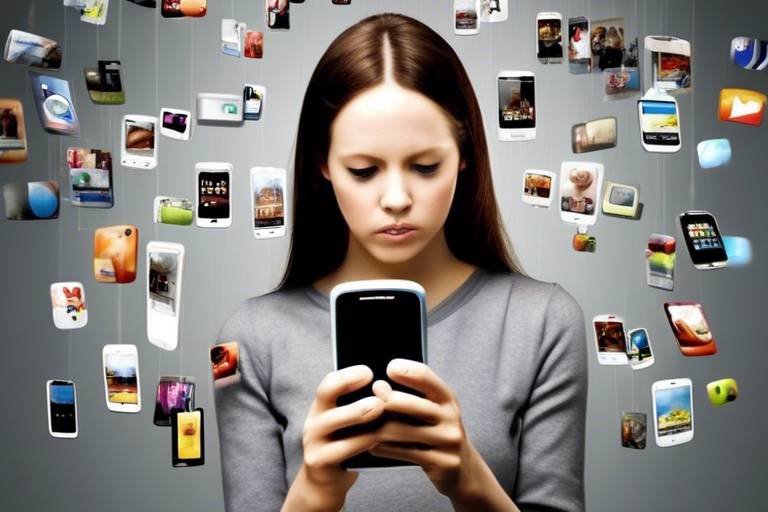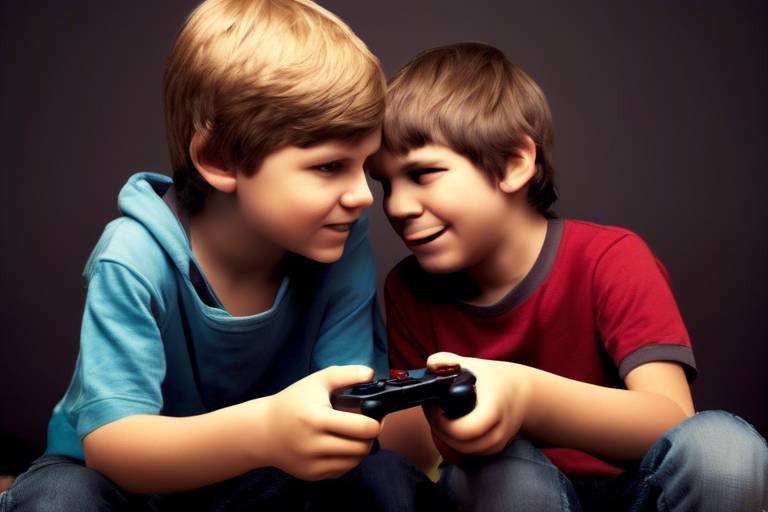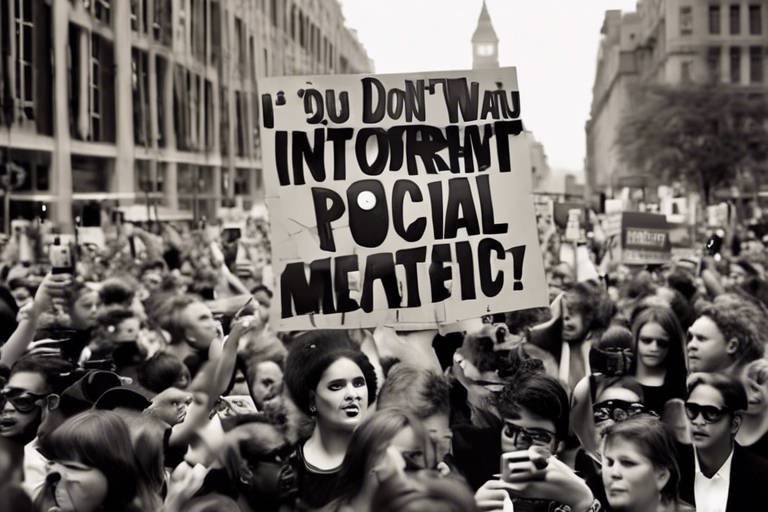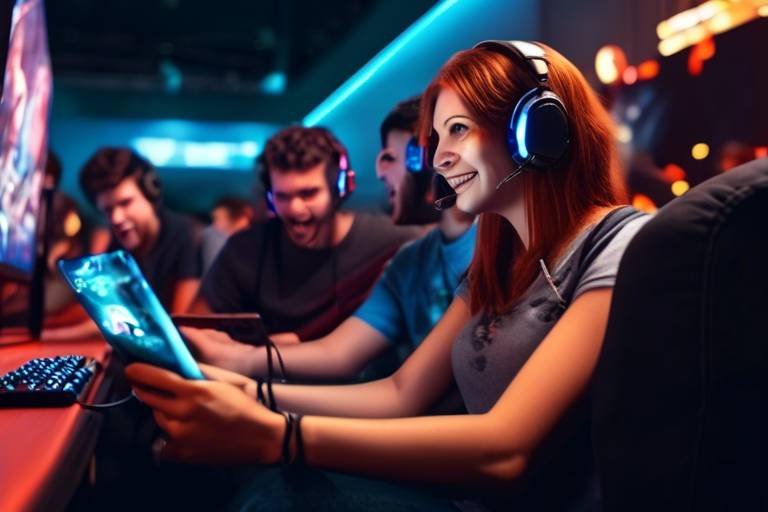The Effects of Digital Communication on Human Behavior
In today's fast-paced world, digital communication has become the lifeblood of our interactions. From texting a friend to sharing a moment on social media, the way we communicate has evolved dramatically. But what does this mean for our interpersonal relationships, social behaviors, and even our mental health? This article dives deep into the intricate web of digital communication, exploring its positive and negative effects on human interactions. As we navigate through this digital landscape, we’ll uncover how these changes shape not only our connections with others but also our inner selves.
Digital communication has undeniably transformed how we connect with others. Gone are the days when a face-to-face conversation was the only way to strengthen bonds. Now, with just a few taps on our screens, we can maintain friendships across vast distances. This shift has led to the rise of online friendships, where individuals forge connections based on shared interests rather than geographic proximity. However, this convenience comes at a cost. The decline of face-to-face interactions can lead to a sense of disconnect, as the nuances of in-person communication—like body language and tone—are often lost in the digital realm. How do we find a balance between the ease of digital communication and the depth of personal interactions?
Social media platforms have become integral to modern communication, acting as both a bridge and a barrier in our interactions. They shape our opinions, foster connections, and, at times, create echo chambers that can skew our perspectives. The influence of social media is profound; it can amplify voices that were once marginalized, allowing individuals to connect over shared causes. However, it can also lead to a narrow view of the world, where differing opinions are drowned out by the noise of like-minded individuals.
While it’s easy to focus on the negatives, social media offers numerous benefits. For instance, it has revolutionized how we communicate, allowing us to share ideas and experiences instantly. Here are some positive aspects:
- Enhanced Communication: Social media platforms facilitate real-time conversations, breaking down barriers of time and space.
- Promotion of Social Causes: They serve as powerful tools for raising awareness about important issues, mobilizing support, and driving change.
- Community Building: Diverse groups can connect, share experiences, and create supportive environments.
Digital platforms allow individuals to connect over shared interests, creating supportive online communities. These spaces are crucial for those who may feel isolated in their offline lives. Whether it’s a Facebook group for hobbyists or a forum for mental health support, these communities provide a sense of belonging. They emphasize the importance of inclusivity, where everyone can find their tribe and feel valued.
Moreover, digital communication has empowered social movements, enabling rapid information sharing and mobilization. Platforms like Twitter and Instagram have become battlegrounds for social justice, where hashtags can spark global conversations. This newfound ability to rally support and share stories has changed the landscape of activism, making it more accessible to people from all walks of life.
Despite its advantages, social media can also contribute to mental health issues. The risks of cyberbullying, social comparison, and addiction to online validation are ever-present. The pressure to present a perfect life online can lead to feelings of inadequacy and anxiety. It’s essential to recognize these pitfalls and navigate the digital world with awareness and caution.
The impact of digital communication on mental health is significant. On one hand, it can foster connections that provide emotional support; on the other, it can lead to feelings of isolation. The paradox of being constantly connected yet feeling lonely is a reality many face in the digital age.
While digital communication can foster connections, it can also lead to feelings of loneliness. With the rise of online interactions, many individuals report feeling more isolated than ever. This irony highlights the need for genuine human connections that go beyond the screen. Are we truly connecting, or are we merely exchanging words?
On a brighter note, online communities can provide valuable emotional support, particularly for individuals facing mental health challenges. These platforms can facilitate access to resources, information, and a sense of community. They offer a place where individuals can share their experiences, seek advice, and find solace in knowing they are not alone.
- How does digital communication affect relationships?
Digital communication can enhance relationships by allowing for constant contact but can also create distance if face-to-face interactions decline. - What are the mental health impacts of social media?
Social media can lead to both positive support networks and negative effects like anxiety and depression due to comparison and cyberbullying. - Can online communities be beneficial?
Yes, online communities can provide emotional support and foster a sense of belonging for individuals who may feel isolated.

Impact on Interpersonal Relationships
Digital communication has fundamentally transformed the way we connect with others, reshaping the landscape of interpersonal relationships in ways we never could have imagined a few decades ago. Have you ever thought about how many of your friendships began online? In today's world, it's not uncommon for people to forge deep connections through screens, whether via social media, messaging apps, or online forums. This shift has brought about a myriad of changes in relationship dynamics, including the rise of online friendships and the decline of traditional face-to-face interactions. It's almost as if we’ve traded in our coffee shop meetups for video calls and emojis!
One of the most significant impacts of digital communication is the way it allows us to stay in touch with people across vast distances. Imagine being able to maintain friendships with someone who lives halfway across the globe! This ability to connect instantaneously can foster a sense of closeness that transcends geographical barriers. However, this convenience often comes at a cost. With so many interactions occurring online, the nuances of face-to-face communication—like body language and tone—can be lost. This can lead to misunderstandings and a lack of emotional depth in our relationships. In a world where we can send a quick text or a meme, are we losing the art of meaningful conversation?
Moreover, the nature of online friendships can differ significantly from traditional ones. While many people find solace and camaraderie in these digital connections, others may experience a sense of superficiality. How many times have you scrolled through your social media feed, only to feel a pang of loneliness despite being surrounded by “friends”? This phenomenon highlights the paradox of digital communication: while it can enhance our social networks, it can also lead to feelings of isolation and disconnection.
Additionally, the dynamics of romantic relationships have also evolved with the advent of digital communication. Online dating apps have revolutionized how people meet and interact. For some, these platforms offer a treasure trove of potential partners, while for others, they may feel overwhelming or impersonal. The thrill of swiping right can sometimes overshadow the importance of genuine connection, leading to what many describe as a "paradox of choice."
In summary, digital communication has undeniably altered our interpersonal relationships, providing both opportunities and challenges. It's essential to navigate this new terrain thoughtfully, ensuring that we maintain the depth and authenticity of our connections. As we continue to adapt to these changes, it raises an important question: how do we balance the convenience of digital communication with the need for genuine human interaction?
- How has digital communication changed friendships?
Digital communication allows for maintaining long-distance friendships but can sometimes lead to feelings of superficiality. - Are online relationships as meaningful as face-to-face ones?
While online relationships can be deep and fulfilling, they may lack some emotional depth found in face-to-face interactions. - What are the risks of online dating?
Online dating can lead to overwhelming choices and may sometimes feel impersonal, making it crucial to find genuine connections.

Social Media Influence
Social media platforms have undeniably become a cornerstone of modern communication. They shape the way we interact, share information, and perceive the world around us. With billions of users globally, platforms like Facebook, Twitter, and Instagram have transformed our social landscape. Ever wondered how a simple tweet can spark a global movement? It's fascinating how digital spaces can amplify voices that might otherwise go unheard.
One of the most significant impacts of social media is its ability to connect individuals across geographical boundaries. People can forge friendships and relationships with others from different cultures and backgrounds, leading to a richer understanding of diversity. However, this connectivity comes with its own set of challenges. For instance, while we may be more connected than ever, many people report feeling more isolated due to the superficial nature of online interactions. The paradox of being 'friends' with hundreds of people online yet feeling lonely is a reality for many.
Moreover, social media plays a crucial role in shaping public opinion. It acts as a double-edged sword; on one hand, it democratizes information and allows for a multitude of voices to be heard, while on the other, it can create echo chambers. These echo chambers occur when individuals are exposed primarily to opinions that align with their own, reinforcing their existing beliefs and potentially leading to increased polarization. For example, a user might follow only those who share their political views, limiting their exposure to alternative perspectives.
Let's take a closer look at some of the positive and negative aspects of social media's influence:
| Positive Aspects | Negative Aspects |
|---|---|
| Fosters connections with diverse individuals | Can lead to feelings of isolation |
| Enhances communication among communities | Encourages social comparison and envy |
| Amplifies social movements and causes | Facilitates cyberbullying |
In conclusion, while social media has revolutionized the way we connect and communicate, it is essential to navigate its complexities with care. Are we using these platforms to uplift and connect, or are we falling into the traps of negativity and isolation? The answer lies in how we choose to engage with these digital spaces.

Positive Aspects of Social Media
In today's fast-paced digital world, social media has emerged as a powerful tool that transcends geographical barriers and connects individuals from all walks of life. One of the most significant positive aspects of social media is its ability to enhance communication. Imagine being able to share a moment from your life with friends and family who live thousands of miles away in just a few clicks. This instant sharing fosters a sense of closeness that traditional forms of communication often lack. Through platforms like Facebook, Instagram, and Twitter, users can maintain relationships, share experiences, and even celebrate milestones together, despite physical distances.
Moreover, social media has proven to be a catalyst for social causes. Activists and organizations can harness the power of these platforms to raise awareness about critical issues, mobilize support, and drive change. For instance, movements such as #MeToo and Black Lives Matter gained momentum through viral posts and hashtags, showcasing the potential of social media to amplify voices that might otherwise go unheard. This democratization of information allows individuals to participate in conversations about societal issues, making everyone feel like they have a stake in the conversation.
Another remarkable benefit of social media is its role in fostering community building. Online platforms create spaces where people with shared interests can come together, regardless of their physical location. Whether you’re a fan of a niche hobby, a particular genre of music, or a specific cause, there’s likely a community waiting for you online. These digital spaces provide emotional support and a sense of belonging, which can be especially valuable for individuals who may feel isolated in their offline lives. For example, individuals facing similar health challenges can find solace in groups dedicated to sharing experiences and resources.
Furthermore, social media can serve as an educational tool. Many users share valuable content that educates others on various topics, from cooking tips to mental health awareness. This exchange of knowledge can lead to personal growth and a more informed society. Platforms like YouTube and TikTok have made learning more accessible and engaging, allowing users to acquire new skills in a fun and interactive manner.
In summary, while social media has its pitfalls, the positive aspects are undeniable. It enhances communication, promotes social activism, fosters community, and serves as an educational resource. As we continue to navigate this digital landscape, it’s essential to harness these benefits while being mindful of the potential downsides.
- What are the primary benefits of using social media? Social media enhances communication, fosters community building, promotes social causes, and serves as an educational tool.
- How can social media help in social activism? It allows for rapid information sharing, mobilization of support, and amplifies voices for various social issues.
- Can social media create a sense of community? Yes, it connects individuals with shared interests, providing emotional support and a sense of belonging.
- Is social media beneficial for mental health? It can be beneficial by providing support networks, but it also has potential downsides, such as feelings of isolation.

Community Building Online
In today's fast-paced digital world, the way we connect and build communities has evolved dramatically. The internet has opened up a treasure trove of opportunities for individuals to find like-minded people, share experiences, and create supportive networks that transcend geographical boundaries. Imagine being able to connect with someone on the other side of the globe who shares your passion for vintage cars or a specific genre of music. This is the beauty of online communities—they allow us to forge connections that we might never have encountered in our daily lives.
Online communities come in various shapes and sizes, from social media groups and forums to dedicated websites and apps. Each platform offers unique features that can enhance interaction and engagement among members. For instance, platforms like Facebook and Reddit provide spaces where users can post questions, share advice, and discuss topics of mutual interest. These interactions can lead to the formation of deep friendships, as members support each other through life’s challenges, celebrate each other’s successes, and create a sense of belonging.
One of the most significant advantages of these online communities is their ability to foster inclusivity. Individuals who may feel marginalized in their offline lives often find solace in digital spaces where they can express themselves freely without fear of judgment. For example, LGBTQ+ youth have found refuge in online forums where they can share their stories, seek advice, and connect with others who understand their experiences. This sense of belonging can be incredibly empowering, helping individuals to build confidence and resilience.
Moreover, online communities often provide access to resources that members might not find locally. Whether it’s mental health support, educational materials, or career advice, these communities can serve as invaluable lifelines. For instance, many mental health organizations now host online support groups where individuals can share their struggles and receive encouragement from others who have faced similar issues. This not only helps in reducing feelings of isolation but also promotes healing and understanding.
However, it’s essential to acknowledge that while online communities can be incredibly beneficial, they also come with challenges. The anonymity of the internet can sometimes lead to negative behaviors, such as trolling or harassment. Therefore, it’s crucial for community members to foster a culture of respect and support, ensuring that these spaces remain safe and welcoming for everyone. Implementing guidelines and moderation can help maintain a positive environment where all voices are heard and valued.
In conclusion, the rise of online communities has transformed the way we connect with others. They provide a platform for individuals to find support, share experiences, and build lasting relationships. As we navigate this digital landscape, it’s vital to embrace the positive aspects of online interactions while remaining vigilant against potential pitfalls. By doing so, we can continue to cultivate vibrant, inclusive communities that enrich our lives and foster meaningful connections.
- What are online communities? Online communities are groups of people who connect over shared interests or goals, often through social media, forums, or dedicated websites.
- How can I find an online community that suits my interests? You can search for groups on social media platforms, join forums related to your hobbies, or explore websites dedicated to specific topics.
- Are online communities safe? While many online communities are safe, it’s important to be cautious. Always protect your personal information and report any negative behavior to moderators.
- Can online communities help with mental health? Yes, many online communities provide support and resources for mental health, allowing individuals to connect with others facing similar challenges.

Social Activism Through Digital Channels
In today's interconnected world, digital communication has become a powerful tool for social activism, allowing individuals and groups to unite their voices and catalyze change like never before. The ability to share information instantly across vast distances has transformed the landscape of social movements, enabling them to gain momentum and visibility at an unprecedented pace. Think about it: a single tweet or post can spark a global conversation, mobilizing thousands to rally around a cause. This is the magic of digital channels.
One of the most significant advantages of social media in activism is its capacity to create awareness. Campaigns that might have taken months or years to gain traction in the past can now go viral within hours. For instance, movements like #BlackLivesMatter and #MeToo have utilized platforms like Twitter and Instagram to highlight systemic injustices and personal stories of oppression. These hashtags not only spread awareness but also foster a sense of community among supporters who might otherwise feel isolated in their struggles.
Moreover, digital channels offer a unique platform for marginalized voices that have historically been sidelined. Activists can share their narratives and experiences directly, bypassing traditional media gatekeepers. This democratization of information allows for a richer, more diverse dialogue around social issues. It’s like opening a floodgate of perspectives that were previously unheard, creating a tapestry of voices that can resonate with a broader audience.
However, the rapid dissemination of information also comes with challenges. Misinformation can spread just as quickly as accurate information, leading to confusion and division within movements. To combat this, activists often employ strategies such as fact-checking and promoting verified sources. For example, many organizations now include links to credible research and data in their posts to ensure that followers are well-informed. This proactive approach is crucial for maintaining the integrity of social movements in a digital age.
Another compelling aspect of digital activism is the ability to organize and mobilize quickly. With just a few clicks, activists can coordinate protests, fundraisers, and community events. Platforms like Facebook and WhatsApp have become essential for organizing grassroots efforts, allowing individuals to connect and collaborate in real-time. This level of organization was evident during the climate strikes led by young activists around the globe, where social media played a pivotal role in rallying millions to take action.
In summary, social activism through digital channels is not just a trend; it's a revolutionary shift in how we engage with social issues. By harnessing the power of digital communication, activists can amplify their messages, build supportive communities, and drive meaningful change. However, it is vital to remain vigilant about the information we share and consume, ensuring that our digital activism is grounded in truth and solidarity.
- How has digital communication changed activism?
Digital communication has made it easier for activists to organize, spread awareness, and connect with a global audience, allowing movements to gain momentum quickly. - What are some examples of successful digital activism?
Movements like #BlackLivesMatter and #MeToo have effectively used social media to raise awareness and mobilize support for their causes. - What challenges does digital activism face?
Misinformation and the potential for online harassment are significant challenges that activists must navigate in the digital landscape. - How can I get involved in digital activism?
You can start by following causes you care about on social media, sharing information, and participating in online campaigns and discussions.

Negative Aspects of Social Media
While social media platforms have revolutionized the way we communicate, they also come with a host of negative aspects that can significantly affect our mental well-being and interpersonal relationships. One of the most pressing issues is cyberbullying, a pervasive problem that has escalated with the rise of online interactions. Unlike traditional bullying, which often happens face-to-face, cyberbullying can occur at any time and in any place, making it particularly insidious. Victims may feel trapped, unable to escape the harassment even in their own homes.
Additionally, social media fosters an environment ripe for social comparison. Users often curate their lives to present an idealized version of themselves, leading others to compare their reality to these unrealistic portrayals. This can result in feelings of inadequacy and low self-esteem. According to a recent study, individuals who spend more time on social media report higher levels of anxiety and depression, highlighting the psychological toll of constant comparison.
Moreover, the quest for online validation can become addictive. The dopamine rush from likes, shares, and comments can create a cycle where individuals feel compelled to post more frequently to receive that validation. This addiction can lead to a decrease in real-life interactions, as users may prioritize their online presence over genuine relationships. A recent survey found that over 60% of respondents felt pressure to maintain their online image, which can lead to stress and burnout.
Another concerning aspect is the creation of echo chambers. Social media algorithms often curate content that aligns with users' existing beliefs, reinforcing their views and isolating them from differing perspectives. This can lead to polarization, where individuals become more entrenched in their beliefs, making constructive dialogue nearly impossible. The consequences of this can be seen in various societal issues, where misinformation spreads rapidly, leading to misguided actions and opinions.
To illustrate these negative effects, let's take a look at the following table that summarizes the key issues associated with social media:
| Negative Aspect | Description | Potential Consequences |
|---|---|---|
| Cyberbullying | Harassment through digital platforms | Emotional distress, anxiety, depression |
| Social Comparison | Comparing oneself to curated online personas | Low self-esteem, feelings of inadequacy |
| Online Validation Addiction | Seeking approval through likes and shares | Stress, burnout, decreased real-life interactions |
| Echo Chambers | Isolation from differing viewpoints | Polarization, spread of misinformation |
In conclusion, while social media can connect us in unprecedented ways, it is essential to recognize and address its negative aspects. By understanding these challenges, we can take steps to mitigate their impact, fostering healthier digital environments that promote genuine connections rather than superficial interactions.
- What is cyberbullying? Cyberbullying refers to bullying that takes place over digital devices like computers and smartphones, making it relentless and often harder to escape.
- How does social comparison affect mental health? Social comparison can lead to feelings of inadequacy and low self-esteem as individuals compare their real lives to the curated, often unrealistic lives of others on social media.
- What are echo chambers? Echo chambers are environments where a person only encounters information or opinions that reflect their own, leading to a lack of exposure to differing viewpoints.

Effects on Mental Health
In today’s fast-paced digital world, the impact of digital communication on mental health is profound and multifaceted. On one hand, it offers a myriad of opportunities for connection and support; on the other, it can lead to feelings of isolation and anxiety. It's a bit like walking a tightrope—balancing the benefits of staying connected with the risks of becoming overwhelmed by the digital noise.
One of the most significant effects of digital communication is the way it can foster feelings of isolation. While we are more connected than ever through social media, instant messaging, and various online platforms, many people report feeling lonelier than before. This paradox is intriguing. Imagine being at a party where everyone is talking, yet you feel completely invisible. This is the reality for many individuals who engage in online interactions but lack meaningful, face-to-face connections. The constant stream of curated lives on social media can exacerbate these feelings, leading to unhealthy comparisons and a distorted sense of reality.
However, it’s not all doom and gloom. Digital communication also provides a lifeline for those struggling with mental health issues. Online communities can serve as support networks, offering a safe space for individuals to share their experiences and seek advice. For example, platforms like forums and social media groups focused on mental health can help individuals find others who understand their struggles. These communities often become a source of comfort and validation, allowing users to express their feelings without the fear of judgment.
Moreover, the accessibility of mental health resources online has significantly improved. Many organizations now provide teletherapy services, enabling individuals to connect with mental health professionals from the comfort of their homes. This has been especially beneficial for those living in remote areas or for individuals who may feel stigmatized seeking help in person. The ability to access resources like articles, videos, and support groups with just a few clicks can empower individuals to take charge of their mental health.
| Positive Effects of Digital Communication | Negative Effects of Digital Communication |
|---|---|
| Access to mental health resources | Increased feelings of isolation |
| Supportive online communities | Risk of cyberbullying |
| Opportunities for social activism | Pressure from social comparisons |
In conclusion, the effects of digital communication on mental health are complex and varied. While it can lead to feelings of loneliness and anxiety, it also offers invaluable support and resources for those in need. The key lies in finding a balance—embracing the positive aspects of digital communication while being mindful of its potential pitfalls. So, the next time you pick up your phone or log into your favorite social media platform, take a moment to reflect on how it makes you feel. Are you connecting or disconnecting?
- Can digital communication improve mental health? Yes, it can provide access to support networks and mental health resources.
- Does social media contribute to feelings of loneliness? It can, especially when individuals compare themselves to others online.
- How can I find support online? Look for reputable forums, social media groups, or teletherapy services that focus on mental health.

Isolation vs. Connection
In today’s fast-paced digital world, we often find ourselves caught in a fascinating paradox: while we can connect with anyone, anywhere, at any time, many of us feel more isolated than ever. It's almost as if the very tools designed to bring us together are simultaneously pushing us apart. Think about it: how many times have you scrolled through your social media feed, surrounded by images of friends at parties or on vacations, only to feel a pang of loneliness? This feeling is more common than we might want to admit, and it raises an important question: can digital communication truly replace the warmth of face-to-face interactions?
On one hand, digital platforms allow us to maintain relationships over long distances, share moments in real-time, and even forge new friendships with people we might never meet in person. With just a few clicks, we can reach out to someone halfway across the globe, share our thoughts, and engage in meaningful conversations. However, this convenience comes with a trade-off. The more we rely on screens to communicate, the less we engage in genuine, in-person interactions. The result? A growing sense of loneliness that permeates our modern society.
Consider the nature of our online interactions. They often lack the depth and emotional resonance of face-to-face conversations. Non-verbal cues—like a smile, a comforting touch, or even just being present—are lost in digital exchanges. This absence can lead to misunderstandings and a feeling of disconnect. For many, the act of typing a message can feel like a poor substitute for a heartfelt conversation, leaving individuals yearning for authentic connections.
Additionally, the constant barrage of curated content on social media can exacerbate feelings of isolation. When we see others showcasing their highlight reels, it can create a distorted perception of reality. We may start to believe that everyone else is living their best life while we are stuck in our own struggles. This comparison can be toxic, leading to feelings of inadequacy and further isolating individuals from their peers.
However, it’s essential to recognize that digital communication isn't inherently bad. It can serve as a bridge, connecting people who might otherwise remain isolated. For instance, online support groups can offer solace to those grappling with mental health issues, providing a safe space to share experiences and find understanding. These platforms can cultivate a sense of belonging and community, which is vital for mental well-being.
In conclusion, the relationship between isolation and connection in the digital age is complex. While technology has the power to connect us, it also poses challenges that can lead to feelings of loneliness. To navigate this landscape, we must strive for a balance—leveraging the benefits of digital communication while also prioritizing real-world interactions. After all, nothing can truly replace the warmth of a hug or the joy of laughter shared in person.
- Can digital communication lead to real friendships?
Absolutely! While online interactions can sometimes feel superficial, they can also foster deep connections, especially when individuals share common interests or experiences. - How can I combat feelings of isolation in a digital world?
Consider scheduling regular in-person meetups with friends or family, engaging in community activities, or limiting your time on social media to focus on meaningful interactions. - Are online support groups effective?
Yes, many people find online support groups to be a valuable resource for sharing experiences and receiving emotional support, especially when face-to-face options are limited.

Support Networks Online
In today’s fast-paced digital world, the importance of cannot be overstated. These virtual communities serve as lifelines for individuals grappling with various challenges, especially mental health issues. Imagine being in a room filled with people who understand your struggles, who can empathize with your feelings, and who offer advice or simply a listening ear. This is what online support networks strive to replicate, albeit in a digital format.
Many people find comfort in sharing their experiences anonymously, which can be incredibly liberating. Online platforms allow individuals to connect without the fear of judgment that often accompanies face-to-face interactions. This anonymity fosters an environment where people feel safe to express their vulnerabilities, share their stories, and seek help. For instance, forums and social media groups dedicated to mental health topics can provide a sense of community that is often missing in our day-to-day lives.
Moreover, these networks can be a source of valuable resources. They often share information about mental health services, coping strategies, and self-help techniques. For example, many platforms have sections dedicated to mental health resources, where members can find:
- Hotlines for immediate support
- Links to therapy apps
- Articles on coping mechanisms
- Information about local support groups
Additionally, the rise of social media has led to the emergence of various mental health campaigns that aim to raise awareness and reduce stigma. Hashtags like #MentalHealthAwareness or #EndTheStigma not only spread important information but also create a sense of solidarity among users. People can share their journeys, celebrate their victories, and support each other through tough times, all from the comfort of their own homes.
However, it’s crucial to approach online support networks with a discerning eye. While many communities provide genuine support, others may not be as helpful. It's essential to engage with reputable groups and platforms where mental health professionals are involved or where the community is moderated to ensure a positive and supportive environment. Always remember, the goal is to find a space that fosters healing and connection, not one that exacerbates feelings of isolation or negativity.
In conclusion, online support networks play a pivotal role in enhancing the mental well-being of individuals. They provide a platform for connection, resource sharing, and emotional support that can be incredibly beneficial, especially in times of distress. As we continue to navigate the complexities of our digital lives, embracing these online communities can lead to profound changes in how we perceive and manage our mental health.
Q: How can I find a reliable online support network?
A: Look for communities that are moderated and have a positive reputation. Websites dedicated to mental health often have forums or links to trusted groups.
Q: Are online support networks as effective as in-person support?
A: While both have their benefits, online networks can provide immediate access to support and resources, especially for those who may feel uncomfortable seeking help in person.
Q: Can I remain anonymous in online support groups?
A: Yes, many online platforms allow users to maintain anonymity, which can help foster open and honest communication.
Q: What should I do if I encounter negativity in an online support group?
A: It’s important to prioritize your mental health. If a group feels toxic, consider leaving and seeking out a more positive environment.
Frequently Asked Questions
- How has digital communication changed interpersonal relationships?
Digital communication has revolutionized the way we connect with others. People now form friendships online, often prioritizing virtual interactions over face-to-face meetings. This shift can lead to a more extensive network of acquaintances but may also diminish the depth of personal connections.
- What are the positive aspects of social media?
Social media offers numerous benefits, such as enhancing communication, promoting social causes, and fostering community among diverse groups. These platforms allow individuals to connect over shared interests, creating supportive online environments where people can find belonging and encouragement.
- Can social media contribute to mental health issues?
Yes, while social media can be a source of connection, it also has its downsides. Issues like cyberbullying, social comparison, and addiction to online validation can lead to anxiety and depression, making it essential for users to be mindful of their social media habits.
- How does digital communication impact mental health?
The impact of digital communication on mental health is a double-edged sword. On one hand, it can foster connections and provide support through online communities. On the other hand, it can lead to feelings of isolation and loneliness, especially when individuals are constantly connected yet feel emotionally distant from others.
- What role do online support networks play in mental health?
Online support networks can be invaluable for individuals facing mental health challenges. They provide a platform for sharing experiences, accessing resources, and receiving emotional support from others who understand their struggles, often making it easier for individuals to seek help.
- What is the paradox of being connected yet feeling isolated?
This paradox arises when individuals engage in digital communication but still experience loneliness. Despite being constantly connected through devices, many people find that these interactions lack the emotional depth and intimacy of face-to-face conversations, leading to feelings of isolation.



















